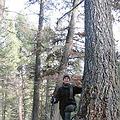 美國三個保育團體4月26日在蒙大拿的聯邦地方法院提告,控訴蒙大拿第一個健康森林復育法案的不合法性。這個於2003年12月開始實行的法律,主要針對預防森林大火的疏伐活動建立法律規範,但批評者指出該法案只是在國家森林進行大規模伐林的煙霧彈。
美國三個保育團體4月26日在蒙大拿的聯邦地方法院提告,控訴蒙大拿第一個健康森林復育法案的不合法性。這個於2003年12月開始實行的法律,主要針對預防森林大火的疏伐活動建立法律規範,但批評者指出該法案只是在國家森林進行大規模伐林的煙霧彈。
三個團體控告美國林務局以及兩位官員,興訟目的在保護比特魯河東支流,以及苦根國家森林內受到「降低東支流中段有害燃料計畫」波及的野生生物棲息地、流域與土壤。「降低東支流中段有害燃料計畫」預期產生1,100萬板呎(board feet)的商用木材,計劃地點位於西蒙大拿州的拉伐麗郡。
目前,該計畫的分析區域已有33%的林木遭到砍伐。此塊分析區域中平均每平方英哩就有5.2英哩長的道路,每年傾倒151噸的沉積物到東支流計畫區的溪流中。
東支流從計畫區的正中心流過,官方分類為受損河流,因為過量的沉積物堆積已經損害生態系統的健全。根據計畫內容,數個流域已經超過「皆伐」的既定門檻,因此隨著河道流量增加,已然威脅到溪流河道的穩定性。
保育團體指出,比特魯國家森林監察員布爾(Dave Bull)的決策還包括在靠近東支流流域,有大批麋鹿、大角羊和北美黑尾鹿棲息、最完整的天然未開發成林的部分地區,進行近3000英畝的工業伐林。
天然森林網絡(Native Forest Network)執行長克勒表示,「過去18個月來我們試圖和監察員布爾協調,提出在東支流上游執行一項有效的社區燃料減量計畫。」
但監察員布爾拒絕了該社區計畫。為了證明拒絕計畫的正當性,布爾表示,社區計畫的提議「對計畫的首要目標,也就是處理野外與城市交界處的火相問題沒有太大的幫助。」
保育團體則宣稱監察員布爾試圖阻止森林署的提案,並且「改變最有效的科學數據,以及清理計畫檔案中和土壤有關的數據」,試圖阻撓大眾認識計畫案對土壤過度開發的傷害。
Three conservation groups filed a lawsuit in federal district court in Missoula Wednesday, alleging that the first Healthy Forest Restoration Act project in Montana is illegal. The law, enacted in December 2003, is supposed to thin forests to prevent wildfires, but critics claim it is a thinly veiled excuse for extensive logging in the national forests.
The groups brought the lawsuit against the U.S. Forest Service and two of its employees in an attempt to protect the East Fork of the Bitterroot River, wildlife habitat, watersheds, soils and public process as related to the Bitterroot National Forest's Middle East Fork Hazardous Fuel Reduction project. The project, which is expected to produce 11 million board feet of commercial timber, is located in Ravalli County in western Montana.
Thirty-three percent of the entire analysis area has already been logged. The analysis area averages 5.2 miles of road per square mile, which dump 151 tons of sediment per year to streams within the project area.
The East Fork, running through the middle of the project area, is officially classified as an impaired stream because its excessive sediment load has compromised its ecological integrity. Several watersheds already exceed established thresholds for clearcutting, which threatens stream channel stability with increased runoff.
The groups point out, the forest supervisor for the Bitterroot National Forest Dave Bull’s decision still includes nearly 3,000 acres of industrial logging in some of the best remaining pockets of unlogged, mature forests up the East Fork, inhabited by huge herds of elk, bighorn sheep and mule deer.
"We tried for the past 18 months to work with Supervisor Bull to implement an effective community fuel reduction project up the East Fork," said Koehler, executive director of the Native Forest Network.
Supervisor Bull rejected the community plan. To justify his rejection, Bull said, the community proposal does "little to address fire behavior in the wildland urban interface which is a primary purpose of this project.
The groups allege that Supervisor Bull attempted to block public knowledge of excessive soil damage in the project area by "altering the best-available scientific data and by purging project file documents related to soils" in an attempt to whitewash the Forest Service's proposal.





